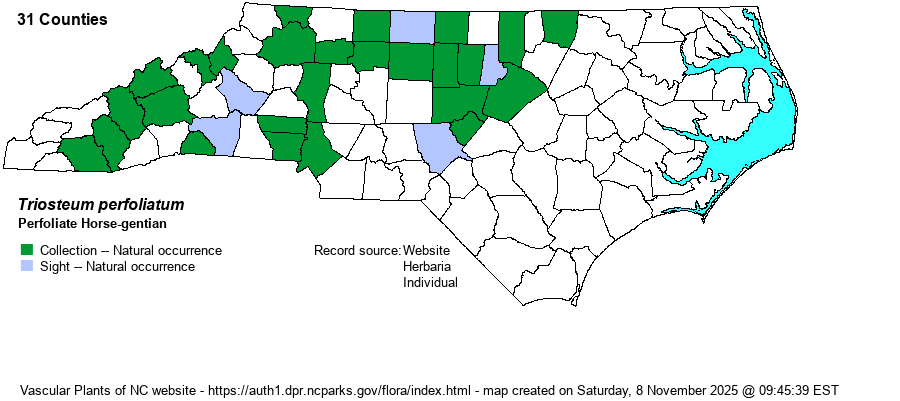| Author | L. | |
| Distribution | Scattered over the Mountains and Piedmont, though scarce in the southeastern Piedmont.
This is a Midwestern and Eastern species, ranging from MA to MN and south to northern GA and eastern OK. | |
| Abundance | Uncommon to infrequent in the Mountains and Piedmont; rare in the southeastern Piedmont. | |
| Habitat | This is a species of mesic to rich hardwood forests, almost always over circumneutral soil. It occurs in Basic Mesic Forests, Rich Cove Forests, and several other rich forest types. It is usually found in shade or mostly in shade. | |
| Phenology | Blooms in May and June, and fruits from August to October. | |
| Identification | This is a somewhat robust herb, averaging about 2 feet tall on a somewhat stout stem, that is densely pubescent but not strongly hispid as are the other two members of the genus. It has several pairs of opposite leaves that are lanceolate to ovate and with broad clasping lobes; leaves average about 6 inches long and 2-3 inches wide. One to several flowers are in the leaf axils, each being tubular in shape, brownish-purple to maroon, and about 1-inch long. The fruit (drupe) is red to orange red. The only other Piedmont member of the genus -- T. angustifolium -- has narrow leaves, a pale yellow flower, and a hispid stem; whereas the more similar T. aurantiacum has broad leaves but are mainly not clasping the stem, and its stem is strongly hispid. T. perfoliatum is the most numerous member of the genus, but it is still rather uncommon and generally a nice find. | |
| Taxonomic Comments | None, though when T. aurantiacum is included within it in some references, this taxon thus becomes T. perfoliatum var. perfoliatum.
| |
| Other Common Name(s) | Late Horse-gentian, Feverwort, Tinker's-weed, Perfoliate Tinker's-weed | |
| State Rank | S3 [S4] | |
| Global Rank | G5 | |
| State Status | | |
| US Status | | |
| USACE-agcp | | |
| USACE-emp | | |

